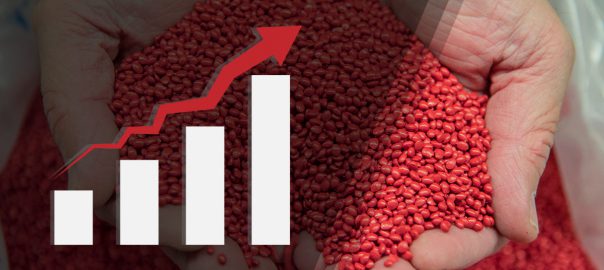If your organisation uses and therefore buys plastic packaging, the enormous price increases and shortages for your plastic packaging have probably not gone unnoticed. The prices of polyethylene, the basis of LDPE, MDPE and HDPE film, have never been this high since 2000.
What causes these increases?
It is not easy to catch the reason in one sentence. Market analysts and producers speak of a ‘perfect storm’ which already indicates a combination of factors that causes these exceptional price increases.
Traditionally, the movement in the naphtha price largely dictates the movement of the derivatives such as PE and PP polymers and the end products derived from them, such as packaging films. Occasionally, other external influences (such as production disruptions due to weather or technical failures) also play a role. The temporary imbalances in supply and demand can push up or down the prices of end products and/or raw materials. At the moment, a lot is going on at once and these influences are reinforcing each other.
Roughly speaking, we see the following happening:
- Limited naphtha (and ethylene) supply due to lower oil production as a result of lower oil consumption (Covid) and the exceptionally low oil prices earlier in 2020
- Scaled-down production (and planned maintenance) at polymer producers due to lower supply on the one hand and lower overall demand on the other
- Unexpected problems (e.g. start-up after maintenance) at some sites
- Production disruptions at petrochemical plants in the United States (US) due to extreme winter weather
- Logistical disruptions due to the global covid situation
- Limited imports into EU due to arbitrage by exporters in e.g. USA and Russia
- Rising demand for specific polymers, such as LDPE and LLDPE
These causes are explained separately below.
1. Limited naphtha supply
Due to the global COVID-19 pandemic, there is a lower demand for oil. This is partly due to less car traffic and less air traffic. Due to this decreasing demand, the price also fell and the refining of oil was scaled back. Naphtha, which is generated during the distillation of crude oil, is therefore also less available. Naphtha is the raw material for the production of ethylene, which in turn is the basis for the production of polyethylene. Since the demand for PE (especially LDPE and LLDPE) remains high, the low availability creates an imbalance in supply and demand. This results in a shortage, which in turn leads to price increases.
2. Scaled-down production (and planned maintenance) by polymer producers
Polymer producers were forced to scale down production and carry out maintenance due to lower availability of raw materials and lower overall demand for plastic products.
3. Unexpected problems (such as start-up after maintenance) at a number of locations
On a number of sites, the shutdown lasted longer than planned due to unexpected problems. The shortages in the supply of LDPE and LLDPE increased as a result.
4. Production disruptions at petrochemical plants in the United States (USA) due to extreme winter weather
The prolonged power outage at the time of extreme frost in the USA caused production lines and crackers to come to a standstill for a long period of time.
5. Logistical disruptions due to the global covid situation
Trade in Asia was partially paralysed in 2020, but this has been scaled up to the old level since the end of 2020. Unfortunately, shipping companies have not yet adjusted their capacity accordingly, says Transport en Logistiek Nederland (TLN). As a result, there is a large shortage of containers. Because of the large shortage of container capacity, transport prices have risen enormously and are not expected to fall any time soon.
6. Limited imports into EU due to arbitrage by exporters in e.g. USA and Russia
Unfortunately, Western Europe largely depends its supply on imports from e.g. America, Russia and the Middle East. As a result of Covid and an increase in the supply of secondary raw materials, the demand for primary raw materials in Europe decreased. In contrast, China experienced an early recovery from Covid and has experienced limited availability of secondary raw materials for some time. The need for primary raw materials therefore increased more strongly, especially in China, making it more interesting for many exporting countries to supply the available raw materials at more attractive prices to China and other Asian countries.
7. Increasing demand for specific polymers, such as LDPE and LLDPE
As mentioned before, the demand in Western Europe for LDPE and LLDPE actually remained high. This was mainly due to the changed consumer behaviour as a result of Covid. Think for example of the high demand for food packaging and more work in and around the house (gardening and DIY). Normally, demand tends to dip in December, but in 2020, influences such as the positive news around vaccines and an expected price increase in raw materials meant that PE processors actually sent in more orders.
The perspective
Unfortunately, the perspective is still uncertain. Judging by the price of naphtha and the forecasts of market analysts, we should prepare for further increases in the coming weeks and months. Although many production sites seem to be starting up again gradually, we also see that there are still a number of producers who need to plan for backlogs. Shortages are therefore expected to persist for the foreseeable future.
KIVO has contractual agreements for the vast majority of its raw materials. This ensures that we are often given priority when it comes to reserving volumes. Unfortunately, a high premium still has to be paid and full availability is not guaranteed.
Contact us
Do you have any questions after reading this article? Please get in touch with your contact person at KIVO or fill in the contact form below. We will do our best to get back to you on the same day.

